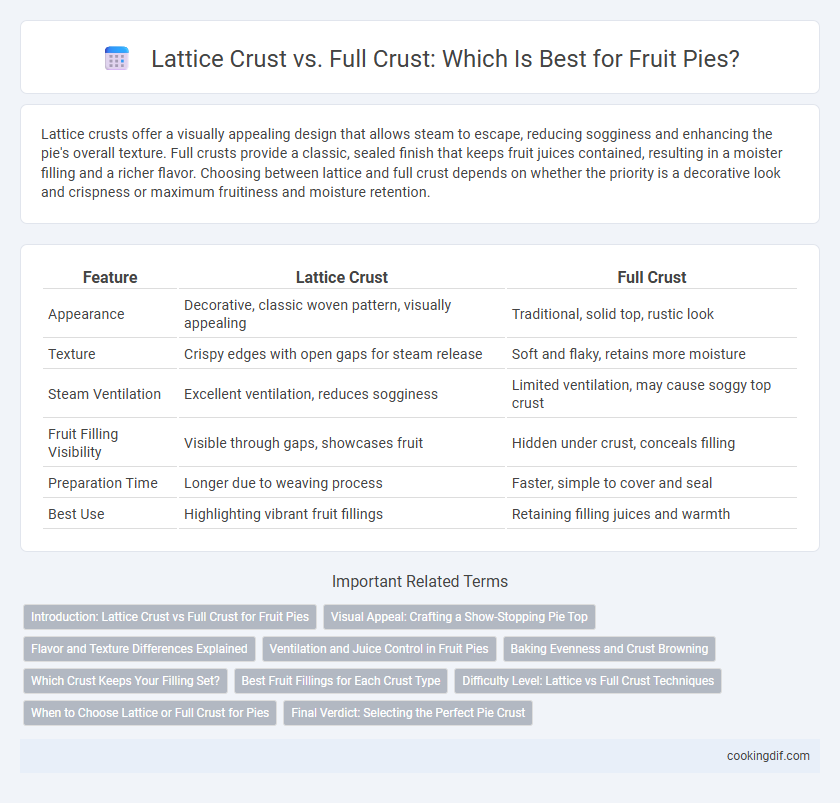Lattice crusts offer a visually appealing design that allows steam to escape, reducing sogginess and enhancing the pie's overall texture. Full crusts provide a classic, sealed finish that keeps fruit juices contained, resulting in a moister filling and a richer flavor. Choosing between lattice and full crust depends on whether the priority is a decorative look and crispness or maximum fruitiness and moisture retention.
Table of Comparison
| Feature | Lattice Crust | Full Crust |
|---|---|---|
| Appearance | Decorative, classic woven pattern, visually appealing | Traditional, solid top, rustic look |
| Texture | Crispy edges with open gaps for steam release | Soft and flaky, retains more moisture |
| Steam Ventilation | Excellent ventilation, reduces sogginess | Limited ventilation, may cause soggy top crust |
| Fruit Filling Visibility | Visible through gaps, showcases fruit | Hidden under crust, conceals filling |
| Preparation Time | Longer due to weaving process | Faster, simple to cover and seal |
| Best Use | Highlighting vibrant fruit fillings | Retaining filling juices and warmth |
Introduction: Lattice Crust vs Full Crust for Fruit Pies
Lattice crusts showcase the vibrant fruit filling through woven dough strips, providing a visually appealing and crisp texture that allows steam to escape, preventing sogginess. Full crusts enclose the filling entirely, offering a buttery, flaky top layer that locks in moisture and intensifies the pie's sweetness. The choice between lattice and full crust affects baking time, moisture retention, and the overall eating experience of classic fruit pies like apple, cherry, and blueberry.
Visual Appeal: Crafting a Show-Stopping Pie Top
Lattice crusts enhance visual appeal by showcasing the vibrant fruit filling through intricate woven patterns, creating an inviting and artisanal look. Full crusts offer a smooth, uniform surface ideal for decorative cutouts or brushed finishes, presenting a classic and polished appearance. Choosing between lattice and full crust depends on whether the goal is to highlight the pie's colorful interior or emphasize elegant top crust decorations.
Flavor and Texture Differences Explained
Lattice crusts offer a lighter, crispier texture that allows steam to escape, resulting in a fruit filling with a more concentrated flavor and less sogginess. Full crusts provide a denser, buttery exterior that traps moisture, yielding a juicier, softer fruit texture and a rich, flaky bite. The choice between lattice and full crust directly influences the balance between crust crunchiness and fruit juiciness in fruit pies.
Ventilation and Juice Control in Fruit Pies
Lattice crusts provide superior ventilation for fruit pies, allowing steam to escape and preventing soggy fillings by promoting even baking. Full crusts trap steam inside, which can cause excessive juice accumulation and a muddled texture in the pie's interior. Effective juice control is crucial in fruit pies to balance moisture retention with maintaining the integrity of the crust and filling.
Baking Evenness and Crust Browning
Lattice crusts allow steam to escape, promoting more even baking of the fruit filling and preventing sogginess, while full crusts often trap moisture, which can result in uneven cooking. The exposed sections of a lattice crust brown more quickly, creating a visually appealing contrast with the softer, less browned dough beneath, whereas full crusts tend to develop a uniform golden-brown color but may risk under-baking in thicker areas. Choosing between lattice and full crusts depends on the desired texture balance between a crispy, browned topping and thoroughly cooked, juicy pie filling.
Which Crust Keeps Your Filling Set?
Lattice crusts allow more steam to escape during baking, which can help fruit fillings thicken and set faster, resulting in less sogginess compared to full crusts. Full crusts trap moisture, often requiring a thicker filling or additional thickeners like cornstarch or tapioca to prevent a runny interior. For the best filling consistency, lattice crusts are ideal when using juicy fruits, while full crusts work better with fruit mixtures that already contain strong natural pectins or added thickeners.
Best Fruit Fillings for Each Crust Type
Lattice crusts offer a visually appealing design that allows steam to escape, making them ideal for thicker fruit fillings like cherry, blueberry, and blackberry that benefit from moisture evaporation and caramelization. Full crusts provide a sealed environment, perfect for juicier fruits such as apple, peach, and pear, as they retain moisture and create a tender, soft filling. Selecting the right crust enhances texture and flavor, with lattice crusts emphasizing tartness and full crusts promoting sweetness and juiciness in fruit pies.
Difficulty Level: Lattice vs Full Crust Techniques
Lattice crusts require advanced pastry skills including precise dough rolling, cutting uniform strips, and weaving them intricately over the pie filling, making them more challenging than full crusts. Full crust pies involve a simpler technique of covering the pie with a single sheet of dough, often requiring only venting slits to release steam. Mastery of lattice work demands patience and dexterity, while full crust methods suit beginner bakers seeking straightforward application.
When to Choose Lattice or Full Crust for Pies
Lattice crusts provide better ventilation, making them ideal for juicy fruit pies like cherry or blueberry to prevent soggy fillings. Full crusts offer a sealed barrier that locks in moisture and flavors, perfect for pies with thick or custard-like fillings such as apple or peach. Choosing between lattice and full crust depends on the filling's moisture content and desired texture, balancing airflow with protection.
Final Verdict: Selecting the Perfect Pie Crust
Lattice crusts offer a visually appealing presentation and allow steam to escape, resulting in a firmer, less soggy filling in fruit pies. Full crusts provide a protective seal that locks in moisture and flavor, ideal for juicier fruits to prevent leaks during baking. Choosing between lattice and full crust depends on the desired texture and appearance, with lattice enhancing crispiness and full crust ensuring a soft, tender edge.
Lattice crust vs full crust for fruit pies Infographic

 cookingdif.com
cookingdif.com